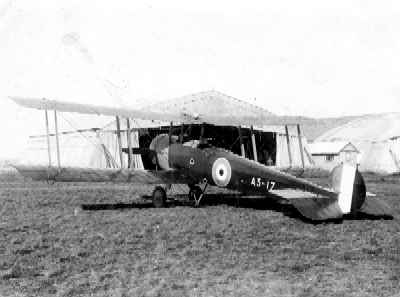As the cortege made the slow, sad, silent march from Flinders street station to the Brighton General Cemetery on the afternoon of Friday 27 March 1925 few of the thousand or so mourners could not have but marvelled at the extraordinary life of Stewart Earl Mailer (c1891-1925).

On the previous Wednesday morning at the Point Cook airbase where Mailer was regarded “as a most efficient pilot and instructor” with the infant Royal Australian Air Force, Flight Lieutenant Raymond James Bronwell had passed the Avro 504K (A3-28), an instructional machine equipped with dual controls, as being fit for service that day. Flying Officer Mailer was scheduled to fly at 9:15 am that fateful morning with 21 year old Cadet Officer Alan Moorhouse Charlesworth (1903-78, Springvale Botanical Cemetery), a Duntroon graduate who had transferred to the RAAF in January that year (“the thrill of flying attracted him”).
Rising to 2,000 feet they made what Charlesworth would describe as “three good” landings. But on the fourth attempt things went terribly wrong. Sitting in the rear seat, Charlesworth was in control being instructed by Mailer through the speaking tubes. At 400 feet, half-a-mile from the hangar and coming in to land for the final time, Charlesworth shut off the engine allowing the aircraft to glide while turning to the left in a 45 degree bank into the wind. But suddenly at 300 feet, the nose began to drop and before Mailer had time to gain control, the plane was in a fearful dive to destruction just a few hundred yards from the outermost hangar.
Mailer took the full brunt of the impact receiving a fractured skull as well as horrific leg, arm and body injuries; his body was crushed into an almost unrecognisable heap while Charlesworth had a miraculous escape from death being saved by his safety belt. He walked away with a sprained ankle, face lacerations and shock (“the rescuers had difficulty in making him lie down until an ambulance would take him to hospital”).
When interviewed at the Caulfield Military Hospital where he would slowly recover from his injuries, Charlesworth was at loss to explain the cause of the accident;
“We had been up for half an hour, and when l cut off the engine and prepared to come down the aeroplane was in perfect control. I cannot account for the sudden dip. It may have been caused by a slight gust of wind under the aeroplane’s tail, but l cannot say. At first I thought that I could right the machine in time, but the nose quickly sank lower, and Mailer came to my aid. Even though I thought there was a chance of avoiding the crash, but it came like a flash”.
With Mailer regarded as “the star pilot at Point Cook in big machines”, The Herald would conclude that the “finest pilot in the world could not have avoided the crash”. Sadly, it was reported that just a few minutes before his death, Mailer had flown over his weatherboard villa in Cherry Street, Werribee waving to his wife, Opal; the newly weds had gone to the theatre the previous night.
Though Mailer was the second flying casualty of the newly formed RAAF after Corporal Bertie Whicker (q.v.) in 1921, his death was not all in vain; Charlesworth would go on to serve a 30-year career in the RAAF (1925-55) attaining the rank of air commodore; in 1945 he succeeded Air Vice-Marshal Adrian (‘King’) Cole as commander of the North West Area responsible for the defence of northern Australia. He retired on 31 December 1955 and was made Commander of the Order of the British Empire (1946).
As the coffin, draped with the Union Jack on which rested Mailer’s sword and cap at the head of the procession neared the corner of Glenhuntly and Hawthorn Road it was indeed a remarkable life the mourners could reflect on. Born in Sydney, New South Wales, he was educated at Sydney Grammar School and Stanley House School, Scotland. On returning to Australia, Mailer received a commission in the 1st Australian Infantry Regiment in 1911 at the age of 21. When war broke out three years later, he was in England and received a commission with the Northumberland Fusiliers arriving in France in September 1915. Later transferring to the Royal Air Force serving with No 141 and 147 Squadrons, on 1 October 1917, Mailer was awarded the AFC and held the Gosport Certificate of Instruction; he resigned his commission with the RAF in December 1922 having attained the rank of Flight-Lieutenant before returning home. On 10 November 1924, he joined the RAAF and was posted to Point Cook. Preceded by the Royal Air Force Band, the motor-trailer carrying the coffin continued down Hawthorn Road to the haunting strains of Handel’s “Dead March in Saul” where it was carried from the trailer by eight non-commissioned officers. An eloquent tribute by the Chaplain General Rev R West Scott was followed by the firing of three volleys over the grave (Pres*T*17A) as the trumpeter played the “Last Post”.
Source:
The Age 26 March 1925 & 23 April 1925.
The Argus 26, 27 & 28 March 1925, 23 April 1925.
The Herald 25 March 1925.
The author gratefully acknowledges the input from Grahame Higgs and Dean Norman (http://www.adf-serials.com).
(Image courtesy Department of Defence Gallery image 000-148-064. Copyright Commonwealth of Australia reproduced by permission)
